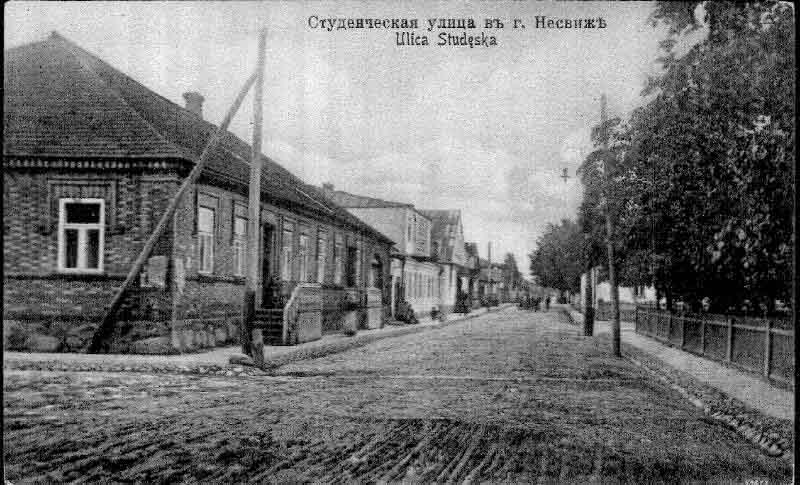

Nesvizh Study Group
 |
|
Nesvizh currently is located in Baranovichi oblast, Minsk guberniya (province) in Belarus, in the former Soviet Union. It is located at 53'13o latitude and 26'40o longitude, 59.9 miles southwest of Minsk. During the period 1921 to 1939, the town was part of the Republic of Poland.
The town historically was owned by the princely Radzivill family. There are references to Jews living in Nesvizh as early as the early 16th century. In 1589, Radzivill granted the Jews certain rights subordinate to the jurisdiction of the prince.
Nesvizh was assigned in 1623 to the Brest-Litovsk province by The Lithuanian Council but just 11 years later became capital of its own province. Nesvizh was a center for fairs, and dayyanim were sent there from all Lithuanian communities.
According to a council decision of 1634, the Nesvizh representative was one of the five men who determined the amount of funds required "to wreak vengeance for murder" referring to a blood libel against the Jews. Of the 60,000 zlotys demanded as poll tax from the whole of Lithuanian Jewry in 1721, the council fixed the share of Nesvizh and the neighboring town of Sverzen* at 1,000 zlotys, as against 1,100 zlotys imposed on Vilna. The Lithuanian Council convened there in 1761, giving the town considerable influence.
The Jewish population of Nesvizh grew rapidly through the 19th century. In 1811, 153 of the 716 Jews in Nesvizh, were craftsmen, including 91 needleworkers, 21 tanners, and 13 barbers. By 1878, the Jewish community had grown to 5053 (72.7% of the total population); 4,678 (55.4%) in 1897; 5,344 (53%) in 1914. As of the 1921 census, the Jewish population had fallen to 3,346 (48.9%).
As indicated by the Merchant Business Book of Addresses in Poland, 1925, Jews were engaged in a wide variety of occupations. Besides commerce and crafts, occupations engaged in by Nesvizh's Jews were horticulture and market gardening, including marketing of agricultural products. It also had a textile factory, a sawmill, and a cooperative Jewish bank.
Nesvizh was known as a center for Jewish learning, and had many other important Jewish institutions. Among the well-known rabbis who officiated in the community at various times were Isaac Elhanan Spektor and Samuel Avigdor "To
sfa'ah." The last rabbi (1941) was Yitzhak Isaac Rabinovitch. Joseph Baer Soloveichik and Pinhas Rozovski were natives of Nesvizh. The community had a yeshivah, a Hebrew school and kindergarten, and a Yiddish school. A branch of Hovevei Zion was founded in 1871 and revived in 1888. There was considerable zionist activity and in the 1930s Ha-Shomer ha-Za'ir maintained a training farm in Nesvizh. An association of Jewish craftsmen originally known as Po'alei Zedek was founded in 1908 and there was also a branch of the Bund and Jewish members of the Communist Party.
Among the outstanding personalities who originated from Nesvizh were the philosopher Solomon Maimon; Eliezer Dillon, who was one of two "deputies of Jewish people" sent from St. Petersburg; Moses Eleazar Eisenstadt, the kazyonny ravvin in St. Petersburg: the authors and educators Jacob Zalman Reizin and Mordecai Ze-ev Reizin; and Nachum Meyer Shaikevich (Shomer), the Yiddish author. The American philosopher, Morris Raphael Cohen, spent much of his childhood there, which he describes in his autobiography, A Dreamer's Journey.
Holocaust Period. In 1939 there were 6,000 Jews in Nesvizh. The town was under Soviet Communist rule 1939-41 during which many community institutions were dissolved and the activities of political parties was forbidden. Zionist youth movements, however, maintained their frameworks underground. Large economic concerns were nationalized, small-scale trade came to an almost complete stop, and artisans were organized in cooperatives. The town was captured by the Germans a few days after the outbreak of war between Germany and the U.S.S.R. on June 1941. Looting and anti-Jewish incidents began. On October 19 a fine of 500,000 rubles and 2.5 kg of gold was imposed. On October 30 all the Jews were ordered to gather in the market square and a "selection" was carried out. From among those gathered, 600 artisans were picked out and the others, about 5,000 in number, were executed near the city. The remnant of the community was concentrated in a ghetto that was surrounded by a wire fence.
An underground movement founded in the ghetto at the end of December 1941 began to acquire arms and to prepare other means of self-defense. When news of the destruction of nearby communities reached the ghetto in July 1942, the underground prepared to fight, with cooperation of the chairman of the Judenrat, Magalif, a lawyer from Warsaw. On July 22 the Germans surrounded the ghetto to carry out a selection. When the Germans broke through the gate, the Jews set their houses afire and defended themselves with the few weapons they had and with knives, hatchets, and sticks. Atlthough a number of Germans were injured, their overwhelming numbers and weaponry, and help from Lithuanian collaborators, soon overcame the inhabitants of the ghetto and most were killed. A few members of the underground succeeded in escaping and fled into the forests. Some organized into a partisan unit and were integrated with the Chkalov battalion of the partisans that was active in the forests of Volozhin.**
Jewish life in Nesvizh was not restored after its liberation by the Soviets. The few survivors went to Poland, and from there some went to Israel and others migrated overseas.
*Most commonly known as Stolbtsy, also Stoptz, Shverzna, and variants; 16 miles north of Nesvizh.
**This uprising is described in detail in: Cholawski, Shalom, Soldiers from the Ghetto: The First Uprising Against the Nazis (San Diego and New York: A.S. Barnes & Co., Inc, 1980). Click the title for a list of names appearing in the book.
Compiled by the members of the Nesvizh
Study Group
Facilitator and Webmaster:Steve
Stein
Copyright © 1997-2017
Created by Mike Meshenberg in 1997
and maintained by Mike Meshenberg until
March 2016
Updated 11/24/2017
Webmaster Emeritus: Brad Lakritz